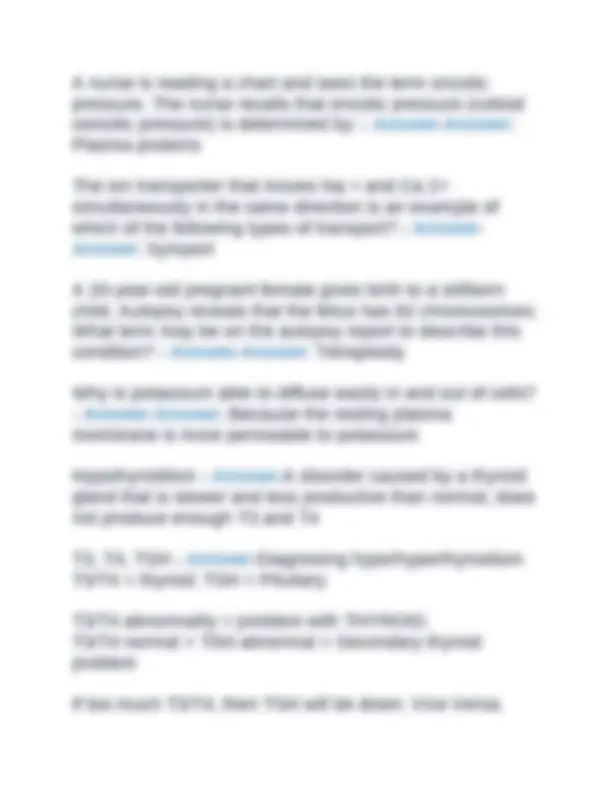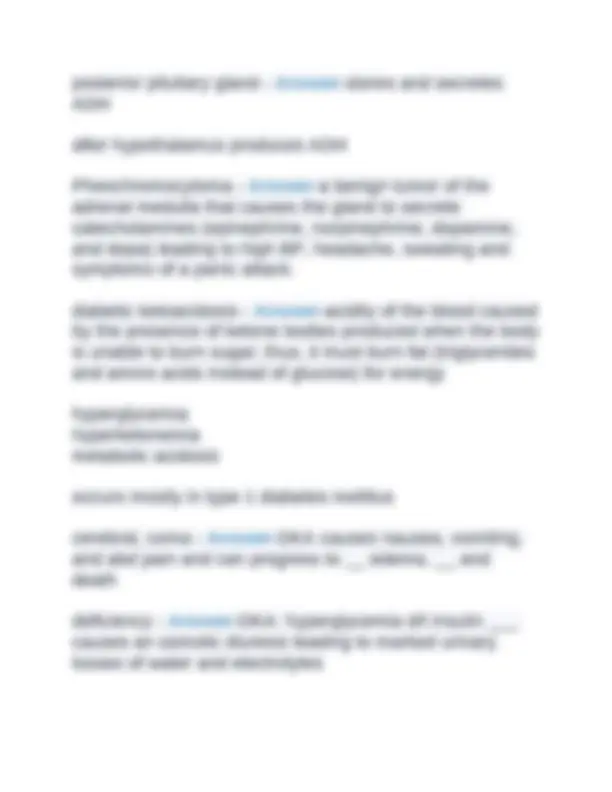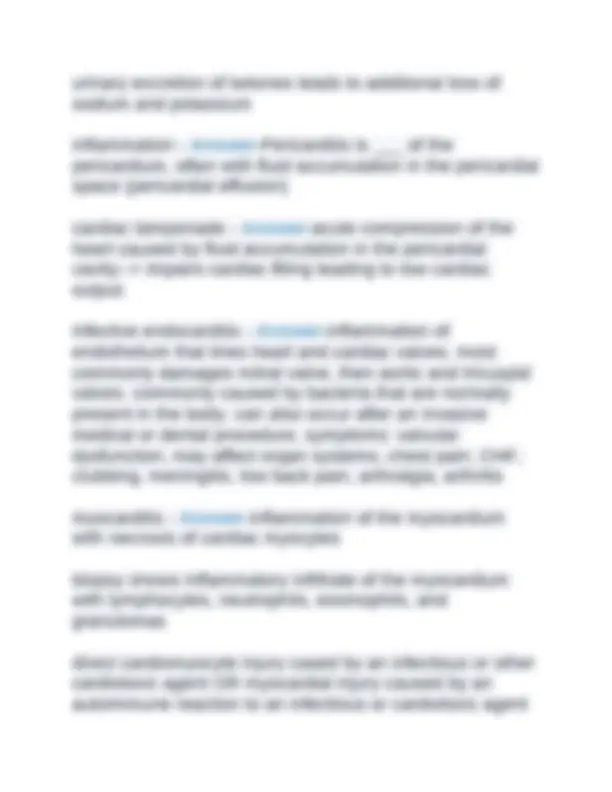








Study with the several resources on Docsity

Earn points by helping other students or get them with a premium plan


Prepare for your exams
Study with the several resources on Docsity

Earn points to download
Earn points by helping other students or get them with a premium plan
Community
Ask the community for help and clear up your study doubts
Discover the best universities in your country according to Docsity users
Free resources
Download our free guides on studying techniques, anxiety management strategies, and thesis advice from Docsity tutors
Advanced Pathophysiology Midterm 6501 Walden University Question and Answers Advanced Pathophysiology Midterm 6501 Walden University Question and Answers
Typology: Exams
1 / 12

This page cannot be seen from the preview
Don't miss anything!







A runner has depleted all the oxygen available for muscle energy. Which of the following will facilitate his continued muscle performance? - Answer - Answer : Anaerobic glycolysis What causes the rapid change in the resting membrane potential that initiates an action potential? - Answer - Answer : Sodium gates open, and sodium rushes into the cell, changing the membrane potential from negative to positive. A 12-year-old male is diagnosed with Klinefelter syndrome. His karyotype would reveal which of the following? - Answer - Answer : XXY A nurse is reviewing the pedigree chart. When checking for a proband, what is the nurse looking for? - Answer - Answer : The person who is first diagnosed with a genetic disease An aide asks the nurse why people who have neurofibromatosis will show varying degrees of the disease. Which genetic principle should the nurse explain to the aide? - Answer - Answer : Expressivity
In teaching a patient with cirrhosis, which information should the nurse include regarding cholesterol? - Answer - Answer : Cholesterol decreases the membrane fluidity of the erythrocyte, which reduces its ability to carry oxygen. When a patient asks what causes cystic fibrosis, how should the nurse respond? Cystic fibrosis is caused by an _____ gene - Answer - Answer : Autosomal recessive How are potassium and sodium transported across plasma membranes? - Answer - Answer : By adenosine triphosphate enzyme (ATPase) The nurse would be correct in identifying the predominant extracellular cation as: - Answer - Answer : Sodium The early dilation (swelling) of the cell's endoplasmic reticulum results in: - Answer - Answer : Reduced protein synthesis What principle should the nurse remember when trying to distinguish aging from diseases? - Answer - Answer : It is difficult to tell the difference because both processes are believed to result from cell injury. What is the diagnosis of a 13-year-old female who has a karyotype that reveals an absent homologous X chromosome with only a single X chromosome present? Her features include a short stature, widely spaced nipples, reduced carrying angle at the elbow, and sparse body hair. - Answer - Answer : Turner syndrome
A nurse is reading a chart and sees the term oncotic pressure. The nurse recalls that oncotic pressure (colloid osmotic pressure) is determined by: - Answer - Answer : Plasma proteins The ion transporter that moves Na + and Ca 2+ simultaneously in the same direction is an example of which of the following types of transport? - Answer - Answer : Symport A 20-year-old pregnant female gives birth to a stillborn child. Autopsy reveals that the fetus has 92 chromosomes. What term may be on the autopsy report to describe this condition? - Answer - Answer : Tetraploidy Why is potassium able to diffuse easily in and out of cells?
calcium - Answer -parathyroid glands responsible for regulating ___ levels. metabolism, temperature - Answer -Thyroid produces hormones T3, T4, and plays big role in __, ___ regulation and growth and development iodine - Answer -Brain cannot make T3 and T4 without
slows - Answer -hypothyroidism everything __. stimulates sympathetic nervous system, drowsy, lethargic constipated, food move slows, weight gain body temp increases Hyperthyroidism - Answer -excessive activity of the thyroid gland: increased levels of T3, T4 and TSH loss - Answer -Hyperthyroidism: burning calories at an excessive rate weight ___ stimulates sympathetic nervous system: alert, quick reflexes, increased HR & BP (fight or flight response Heat intolerance: increased body temp Active GI: diarrhea anterior pituitary gland - Answer -the anterior part of the pituitary gland; an endocrine gland whose secretions are controlled by the hypothalamic hormones
releases ATCH adrenocorticotropic hormone --> adrenal cortex to release cortisol increased - Answer -Cushings disease has ___ secretion of cortisol decreased - Answer -Addison's disease has __ secretion of cortisol and aldosterone Need to ADD some steroids syndrome - Answer -Cushing ___ is when an outside cause results in too much production of cortisol, like treatment with steroids disease - Answer -Cushings ___ is when an internal issue is causing over production of cortisol autoimmune - Answer -Addison's disease is typically an ____ disorder where the body is attacking the adrenal cortex on top of the adrenal gland Cushing's - Answer -___ symptoms: skin fragile truncal obesity, small extremities with striae on them excessive hair "moon face" buffalo hump
females --> no menstruation males--> ED hyperglycemia d/t high cortisol Addison's - Answer -___ symptoms: brownish hyperpigmentation of skin diarrhea, nausea hyponatremia d/t low aldosterone levels --> hyperkalemia hypoglycemia d/t low cortisol low bp, risk for vascular collapse going into shock Anti-diuretic hormone - Answer -aka Vasopressin ADH is a hormone made by the hypothalamus in the brain and stored in the posterior pituitary gland. It tells your kidneys how much water to conserve. ADH constantly regulates and balances the amount of water in your blood. increase - Answer -SIADH will have ___ in antidiuretic hormone decrease - Answer -Diabetes insipidus will have a __ in ADH
urinary excretion of ketones leads to additional loss of sodium and potassium inflammation - Answer -Pericarditis is ___ of the pericardium, often with fluid accumulation in the pericardial space (pericardial effusion) cardiac tamponade - Answer -acute compression of the heart caused by fluid accumulation in the pericardial cavity--> impairs cardiac filling leading to low cardiac output. infective endocarditis - Answer -inflammation of endothelium that lines heart and cardiac valves. most commonly damages mitral valve, then aortic and tricuspid valves. commonly caused by bacteria that are normally present in the body. can also occur after an invasive medical or dental procedure. symptoms: valvular dysfunction, may affect organ systems, chest pain, CHF, clubbing, meningitis, low back pain, arthralgia, arthritis myocarditis - Answer -inflammation of the myocardium with necrosis of cardiac myocytes biopsy shows inflammatory infiltrate of the myocardium with lymphocytes, neutrophils, eosinophils, and granulomas direct cardiomyocyte injury cased by an infectious or other cardiotoxic agent OR myocardial injury caused by an autoimmune reaction to an infectious or cardiotoxic agent
aortic regurgitation - Answer -(aortic insufficiency) incompetent aortic valve that allows backward flow of blood from the aorta into left ventricle during diastole aortic stenosis - Answer -calcification of aortic valve cusps that restricts forward flow of blood during systole narrowing of the aortic valve, obstructing blood flow from the left ventricle to the ascending aorta during systole mitral regurgitation - Answer -mitral insufficiency; incompetent mitral valve allows regurgitation of blood from the left ventricle back into left atrium during systole mitral stenosis - Answer -narrowing of the mitral valve orifice that impedes blood flow from the left atrium to the left vetricle mitral valve prolapse - Answer -Improper closure of the valve between the heart's upper and lower left chambers. billowing of mitral valve leaflets into the left atrium during systole pulmonic regurgitation - Answer -pulmonic insufficiency; backflow of blood through incompetent pulmonic valve into the right ventricle causes blood from from the pulmonary artery into the right ventricle during diastole